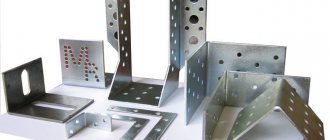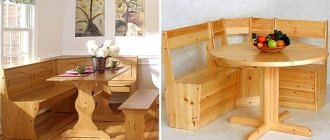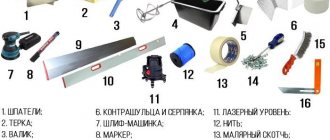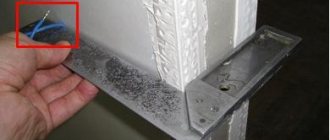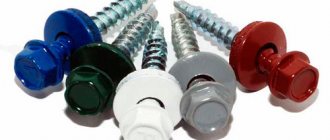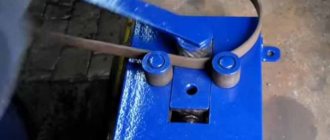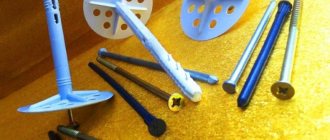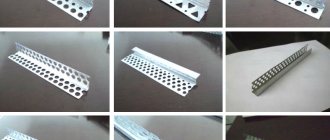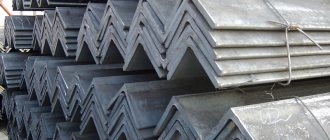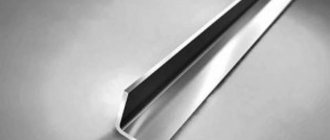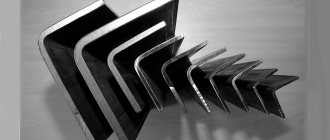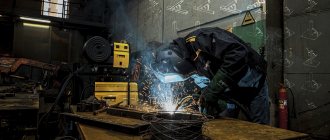For any construction, fastening and finishing elements are needed that will reliably and firmly hold the created structure made of wood, metal, plasterboard, etc. They facilitate technological processes when constructing structures. One type of such fastener is a perforated corner. This indispensable hardware simplifies many installation-related jobs. It is strong and durable, and most importantly, it ensures a long life of structures for construction.
Drywall corner - types of products and features of their use
Don’t know how to make perfectly even corners in plasterboard structures? Then this review is for you, in it I will talk about the types of corners used in the work and show you step by step the process of installing them. By following simple recommendations, you can easily make strong and perfectly even corners.
There are corners for both flat and arched structures
Types of products and features of their installation
I will tell you about 4 types of corners, and then I will consider the process of installing elements on the corner of the wall, this is the most common type of work.
Types of corners
The following product options are available for sale:
| Image | Description |
Metal perforated corner. The most common option, which is an element made of thin metal with perforation and a stiffening rib along the edge. Products can have a length of 250 and 300 cm, they are light, but poorly resistant to deformation during transportation and storage.
| |
| Plastic products . They differ from those described above in the material of manufacture. This option is not afraid of moisture and is not subject to corrosion, but its resistance to deformation after installation is lower than that of metal products. The main advantage of this solution is its low price. | |
| Arched corner . The name makes it clear what this group of products is intended for. The elements bend, and this is their main advantage over all others. They are made of plastic, as this material provides the necessary flexibility. | |
| Products with mesh . Such elements are indispensable where you need to strengthen corners and make them resistant to damage. Most often they are used outside buildings, but they can also be used successfully on plasterboard structures if the corners are uneven and fragile. |
If you need a 90 degree corner connector for drywall, then this item has nothing to do with corners. It refers to the elements of the frame construction and is used when assembling the structure.
Corner connector has nothing to do with corners
How to carry out work
Before starting the workflow, you must stock up on everything you need:
- Corner . The quantity and type of products are calculated based on the fact and purchased with a small reserve, since waste will inevitably be generated;
- Putty . I recommend using “Vetonit” compounds, they are easy to use and of high quality;
Vetonit brand compositions are of high quality
- Primer , with its help, drywall is strengthened. The putty surface is then processed.
The tool you need is the following:
- Metal scissors . With their help, you can cut elements quickly and perfectly smoothly, without disturbing the geometry of the product;
- Brush . Used for applying primer;
- Wide and narrow spatulas . With their help, putty is applied;
It is convenient to level the surface with a wide spatula, and to distribute the composition over the main device and apply it to the corners with a narrow spatula
- Sanding block. With its help, all imperfections on the surface are removed, and the angle is leveled to a perfectly flat state.
Instructions for doing the work yourself consist of the following steps:
Which is better: heated floors or radiators?
Warm floorBatteries
This is what the workflow diagram looks like
The perforated corner for drywall is installed like this:
| Illustration | Description of the stage |
The surface is primed, the corner is tried on. Everything is simple here: a strip of at least 30 cm of soil is applied to the corner on both sides. Then you either place a corner or measure with a tape measure to know exactly the length of the elements you need.
| |
| The corner is cut . To do this, take metal scissors and cut the element on both sides according to the marks. After this, it will break very easily, and you will get a smooth and neat end. | |
| Putty is applied to the corner . A small amount of the composition is prepared, after which it is distributed in a layer of 3-4 mm over the entire joint on both sides. This work is most conveniently done using a narrow spatula. | |
| The corner is pressed . This must be done carefully so that the element is even along its entire length; putty should come out of the holes, as in the photo. Align it and check that it adheres well to the joint everywhere. | |
| Putty is applied over the corner . The composition is distributed over a width of up to 10 cm; if you have a slope corner, then you can finish the entire slope. Don't worry about the amount of putty - you can remove all excess without any problems. | |
| The angle is leveled . To do this, use a wide spatula, which is best worked from bottom to top. You evenly distribute the composition over the entire length and immediately remove the excess that inevitably forms. The spatula is positioned at an angle to the surface and applied with slight pressure. | |
| This is what the result of the first stage looks like . The putty is distributed in a strip of approximately 10 cm, do not pay attention to the sagging along the edges, we will remove them in the next step. | |
| The corner is polished . A special bar is used for this. You carefully remove all sagging and irregularities and prepare the surface for finishing. | |
| After sanding the first layer, the second is applied . The composition is distributed even wider, this will eliminate the difference between the wall and the putty. The application width should be already 20-30 cm. | |
The angle is leveled. The process looks like this:
|
Installation instructions for drywall corners
Galvanized corner for plasterboard 25x25 mm is one of the types of material that is used to level parts of walls. As you know, drywall is popular in construction and is easy to work with. However, prefabricated interior partitions made of plasterboard have problem areas - corners, which are most often subject to mechanical stress. This is where the different types of existing corners come to the rescue.
They perform the protective function of parts of the walls and will help to build even corners. Knowing their classification, you can choose a suitable specimen.
Full contents of the material
Types of corners and features of their use
The most common product options are:
Metal perforated corner
This type is a thin sample made of a profile with perforation and a rigid edge along the edge. There are basically 2 types of similar corners for drywall:
These representatives have many subspecies. The corners are not glued, they are practically “slung” onto the structure and secured with putty or gypsum plaster.
Straight perforated corner is used for processing the inside and outside of corners.
It is a V-shaped profile with many holes - perforations.
Options for metal perforated corner for drywall
Actually, with their help, a high-quality connection with the processed corners occurs, and the top, located at the internal corners - inside, and at the external corners - outside, is a guide for the spatula. Excess air also escapes through the holes. Straight perforated corners are made of plastic, aluminum, and galvanized. The latter is tougher than the others, and the wide one can generally be used as a plaster beacon.
Plastic corner
This sample is more resistant to moisture than the profile, but its resistance to mechanical damage is lower. Among the advantages are the low price and the absence of corrosion of the material. There is also a type of plastic corner, for example, AquaBead, which has special paper with glue applied in the inside. Putty is not required for fixing here; just moisten the adhesive surface with water and simply glue the corner to the desired place.
Arched
When installing a gypsum plasterboard arch in the opening, various finishing materials are used, such as plaster, wallpaper, panels and others. But in order to preserve the transition points between planes, an arched corner, which has great capabilities, is used. Arched corners are divided into the following types:
- Installed under plaster, perforated. They have separate petals on one side of the corner, allowing you to place a sufficient strip on any arched curve. There are plastic and profile ones;
- Decorative, which are glued to the plaster.
Before attaching the arched corner, you need to match it with the main finish or in contrast, so the design will look more original.
Products with mesh
Such elements are used in places that require strengthening corners and protecting them from damage. Plaster mesh corners are designed for internal and external corners. They can be made of either plastic or metal profile. The choice will be influenced by the shape and material of the finishing surface.
Installation of corners on drywall using corners
When starting to install a corner on drywall, you need to have tools and material on hand.
Required material
- the selected type of corner will need to be purchased with some reserve;
- using a primer, the surface of the drywall is strengthened;
- It is best to buy Vetonit putty, which is of high quality.
Tools
- metal scissors will help you cut out the necessary parts correctly and quickly;
- a brush that will be needed to apply the primer;
- wide and narrow spatulas will be needed for puttying drywall;
- The sanding block will remove all unevenness on the plane, while the angle will be perfectly even.
This is what mounted corners on drywall look like.
When starting installation, you need to familiarize yourself with the sequence of leveling the corners with putty so as not to damage this fragile material.
Stages of work
- First, the surface must be thoroughly cleaned and treated with a primer. You need to proceed to the next stage only after it has completely dried.
- Measurements are taken and the required length of the corners is cut. They are applied to the drywall as a sample.
- For further work, you will need non-woven tape, serpyanka mesh for the internal corners, one of the types of perforated corners: plastic, adhesive, rounded, either made of a metal profile or paper-based.
- Before you putty the gypsum plasterboard corners, you should select a putty for the gypsum plasterboard. To form internal and external corners, it is better to buy a dry gypsum mixture. It has a reasonable price, good quality and can securely fasten elements to the structure.
- The putty is prepared following all the steps: poured, poured, stirred, allowed to settle, kneaded again.
- When working with external corners, you need to remember that they are most often subject to mechanical stress; it is better to mount metal samples, in some cases having a rounded shape.
- Check the flatness of the end.
- Putty is applied to the area to be treated with smooth movements. Without allowing the composition to dry, you need to secure the corner with pressure, check the accuracy with a level, and if necessary, you can tap with a rubber mallet.
- Sometimes the corner is attached to the drywall with a stapler or glued with glue, and then covered with putty.
- Another layer of the mixture is applied to the installed element and now alignment occurs with the general plane of the wall.
Applying a second layer of putty
- After thorough drying, the slope corner is polished.
- Installing corners inside the structure looks similar, even a little easier. Carefully coat the adjacent sides and the gap between the corners with a spatula, and remove excess mixture. A reinforced tape having the desired shape is glued onto the dry, sanded surface. You can also buy a serpyanka mesh, just apply it to wet putty.
- Using a building level, check the fastening of the corner on the plasterboard, then use the next layer to hide the unevenness.
- After thorough drying, the surface is finished with sandpaper or a sanded block, forming a perfect angle.
- To facilitate the leveling process, so-called beacons are used, attached to the surface with a plaster solution; here you can do without fastening parts.
- Separately, I would like to mention the semicircular plastic corner, used in rooms with the maximum possible impact on the corners. It is made of flexible plastic and has a semicircular angle rather than an acute one. Its price is quite reasonable, and its durability is beyond doubt. It differs in some features at the installation stage, namely cutting the end by 1.5-2 cm with an angle of 45 ͦ . A corner is pressed into the applied initial putty, fixed with a stapler, and the edges are treated with the mixture.
A video of arranging corners will help you see how parts of drywall are reinforced, and will also allow you to select and buy the necessary elements.
Finishing internal and external corners will not seem difficult with the right approach and the necessary training. The main thing is that during installation, smooth walls of plasterboard without a frame must be made, requiring minimal finishing.
Perforated corner for plaster
Home renovation is a desire for beauty and comfort. And it’s not scary if the walls are not level or there are differences in plane. The main thing is that it is visually smooth and beautiful. How to achieve this?
Few people know that the secret to the visual beauty of walls lies in a straight, clear edging. This concept refers to the following areas of application of plasters and putties:
- external and internal angles;
- junctions of walls at ceilings and floors;
- protruding parts of any structures (arches, boxes, other structures).
All these places (edges) must correspond to the intended design. Straight should be straight, oval should be oval. The former plasterer-painter achieved acceptable quality with almost his bare hands. But modern accessories simplify and speed up the process.
In fact, all of them are perforated corners for plaster. There are only two varieties of it - straight and arched, and there are many more subspecies. They are used almost everywhere where plaster mixtures with putty are used.
Grouting corners and leveling wall surfaces
After the plaster mixture has hardened in the places where the corner pads are placed, plastering work is carried out in stages:
- using a trowel placed at an angle of 30-40°, the base is grouted;
- then a solution is applied near the profiles, which is smoothed using a rule to eliminate excess mixture;
- smooth the surface with a trowel;
- the bases are leveled, while the corners should not protrude outward;
- Polymerization is carried out on the dried wall panel and the final grouting begins;
- internal corners are rubbed using a grater with a sponge surface.
Right angle.
A right perforated angle can be used for internal and external corners. It can be of different widths, as well as aluminum, galvanized or plastic (polyvinyl chloride). In general, there is no difference. You can’t say that one is better or worse. But galvanized corner is more rigid than others. Especially the wider one. Therefore, it is convenient to use it as a plaster beacon.
Tip: Use good, sharp tin snips to cut the corner, as the bent edges will get in the way. On the other hand, plastic products can be cut perfectly with a regular stationery knife. If you don’t have a knife, scissors, or grinder at hand, then you can simply break the perforated angle. Uneven edges can be easily straightened with pliers, a hammer or just your fingers.
Any straight corner for plastering corners is a V-shaped profile. Its sides (shelves) have many holes throughout their entire plane - perforation. The top of the corner stands out, that is, it sticks out relative to the shelves by approximately 1 mm. Moreover, at the inner corners it sticks out inward, and at the outer corners it sticks out. Perforation is needed for reliable fastening, the top is like a guide for a spatula.
Tip: In order to cut a dozen perforated corners of the same length, you can fold them one into one, then, after measuring with a tape measure, cut off the entire pack, say, with a grinder. And 2-3 pieces will be cut through by metal scissors.
The purpose of the perforated corner and how to install it
Depending on the task at hand, this finishing accessory can be installed in two ways: on a curved corner and on a leveled one.
The corner is a beacon.
In the first case, the product will serve as a plaster beacon. To install it, a plaster mixture is applied to the base corner. By the way, it is more convenient to work with gypsum plaster than with cement plaster. It should not be applied along the entire length of the edging, but in such flat cakes - for the convenience of adjusting the angle along the plane and level. This adjustment is made using a building level and a plaster rule.
Tip: If you add a handful of cement or any cement mixture to gypsum plaster, the plaster beacon will set in a matter of minutes. You can continue working immediately. Where perpendicular planes intersect, it is advisable to cut the overlapping corners at 45 degrees to avoid overlap.
It should be noted that the internal perforation angle is extremely inconvenient to use as a beacon for plaster. It is only suitable to emphasize the straightness of the edging.
In walk-through areas where external corners may be subject to more intense mechanical loads, it is recommended to install a corner with a mesh under the plaster. Fiberglass plaster mesh, firmly connected to a plastic or metal corner, serves as a means of reinforcing the corner.
This type of perforated corner is used precisely as a beacon. After all, it is almost impossible to hide the mesh under a layer of finishing putty, since about 5 mm of plaster must be applied on top of it
Advice: If you want to reinforce a regular perforated corner, you can cover its shelves with a sickle mesh, covering the wall. Strips of non-woven fabric or fiberglass are also perfect for this purpose. The same putty can be used as glue.
A variety of shapes of plaster corners made of plastic (PVC) and metal
According to configuration, profiles are available in the following subtypes:
- arched;
- straight;
- universal;
- with reinforced mesh for plaster;
- combined;
- perforated;
- paper, etc.
Right angles for slopes
Right angles are made of metal alloys and plastic. The product is shaped like a strip, bent at a right angle in the center. The profile edging is perforated for easy fixation on the base and improves adhesion characteristics. The thickness of the metal element reaches 0.5 mm, the polymer components - 1-1.5 mm.
The advantage of plastic corners is the absence of corrosion, therefore polymer elements are used for finishing facades and other external works. The thickness of such products with a right angle can reach more than 1-1.5 mm, so the element is not suitable for puttying the surface. However, for plastering work, a plastic corner is used.
Arched
Arched elements are divided into compact sections for easy bending when finishing arches and niches. Arched corners are used to level the side sections of arches, passages, and curved structures made of plasterboard ceilings on wall panels and ceilings. The product is used for external and internal corners.
Perforation in these elements is applied to one side or sidewall. The segmental design allows you to create even corners in complex architectural structures.
The advantages of arched profiles are as follows:
- elimination of uneven corner surfaces in arches;
- visual highlighting of an inconspicuous part of an arch or opening;
- the elements do not require additional processing and are fixed with an adhesive base;
- When done correctly, the products retain the aesthetics of the arched opening for a long time (up to 50 years);
- A wide range of colors of plastic corners for arches allows you to implement complex design solutions.
The work can use corners that are mounted under the plaster layer, and decorative elements for the final stage of finishing; they are fixed to the plaster. Elements for internal installation are often perforated, made of metal alloys or plastic. Decorative corners are represented by a wide range of materials; polyvinyl chloride, metal, cork, etc. are used in their production.
Universal
Universal products, made of plastic or metal alloys, have the shape of a tape, which can be used to edge non-standard areas of surfaces. The corners reach a width of 5 cm. The bending line of the element is located in the center, the corner is complemented by perforation. The products are made of high-quality plastic, ensuring durability during operation.
With reinforcing mesh
A corner with a metal mesh is used for wet plastering. The peculiarity of mesh products is the presence of perforated pads about 2-4 cm wide. Using these elements, you can level surfaces of different configurations.
The material is often used for facade finishing, including plastering over insulation. The mesh allows the mixture to pass through and is securely fixed to the wall panels. The elements are recommended for use when making a thick layer of plaster. Mesh inserts provide additional structural strength and allow you to create even angles on surfaces of complex configurations.
Combined type
Combined type corners are made from different materials. The list of popular products includes metal profiles with thick paper edging. The products are optimal for leveling the outer and inner corners of wall panels for putty. The elements are fixed with an adhesive solution.
Combined corners are created from aluminum or galvanized metal and fiberglass mesh. The products are durable and are used to create clear contours of corners on the outside of the wall. Using profiles, you can create smooth joints between surfaces made of different materials.
The mesh that complements the element can be plastic. These products, in addition to leveling corner areas, increase the strength of the base.
Perforated
Perforated corners for plaster are used to level outer corners or inner corner areas. The products are in demand, easy to install, and universal in use. Elements are produced for corners and can be plastic, galvanized, aluminum.
Products are produced in different widths. For accurate alignment, the material must be trimmed. To adjust metal elements, metal scissors are used. Galvanized profiles are characterized by increased rigidity and can be used as beacons during plastering. A perforated corner for putty is used to level the base and eliminate cracks.
Paper
Paper corners are made in the form of masking tape and sold in rolls. In the center of the strip of thick paper there is a marking for the fold. The canvas can be produced with fine perforation or on a self-adhesive basis. Paper corners are used to prepare corner sections of plasterboard walls and surfaces of other materials for applying the finishing layer of putty.
The products are also used to prepare plastered substrates for painting. Masking tape is often applied over the putty.
However, large deformations in corner areas cannot be corrected using paper corners. Therefore, you will need to use durable elements made of metal and plastic.
Corner - protective cover.
If the wall, along with all its corners, is already well-plastered, then the purpose of the perforated corner will be to protect the corner from mechanical damage and emphasize a straight line.
The technology for its installation is basically the same as the first option. Only the layer of the solution used should be minimal, the consistency of the mixture should be more liquid.
To achieve this goal, a plastic or aluminum corner for plaster is ideal. In addition, it is not at all necessary to fix it with a plaster mixture or putty. After all, the base is already straight, which means that the corner should be pressed tightly against the base, hugging it.
Such installation is possible using small screws, nails or staples. You just need to make sure that the corner itself and its shelves are not deformed in the process.
Tip: Often, protruding screws and nails interfere with puttying with their heads. To avoid this, they can be removed after the corner has set.
In addition, installation of a perforated corner with a minimum layer of mortar is necessary, as a rule, when finishing gypsum plasterboard structures. Of course, provided that they are assembled with more or less high quality.
In this case, a self-adhesive perforated corner is perfect - it has strips of glue on the inner sides of the shelves, which are activated by ordinary water. If there is a need to join corners, it must be done using the same materials: plastic ones are connected to plastic ones, etc.
The fact is that different corners for plaster may differ in size, which will affect during finishing.
Correct positioning of the angle relative to the plane
If everything is clear with the positioning of the perforated corner for painting - it is installed with the most protruding part in the same plane with the walls, then with positioning for the wallpaper the situation is different. Here we will consider the second version of the corner. After understanding how the “wallpaper” corner should be positioned, there should be no difficulties with other products.
So, let's go through the installation options from best to least acceptable.
Perhaps this installation option can be considered ideal: the profile is installed in a specially made recess, followed by filling. Therefore, the plane of both walls remains straight.
However, the option above is not always suitable for any specific case: the base is made of unplastered concrete, thin (9.5 mm) drywall, or there is simply no time to make a notch for the corner (you need it cheap and cheerful).
By the way, 12.5 mm. Drywall recess is perfectly chosen when there is time. The main thing you need to understand is that if you plan to paint without reinforcement (with the same fiberglass), it is better not to make a recess!
In general, it would be a good idea to initially install the gypsum board with a thin factory edge on the outer corners - then the notch at the corner will appear on its own.
In fact, such an angle in reality does not look as scary as in this diagram. Broken planes can be pulled out efficiently, but wouldn’t it be easier to sample the base before installing the corner?
In the second option, no sampling of the base is done. Instead, you will have to stretch both planes near the corner with a wide spatula or a small rule.
In this option, the corner for wallpaper is used in the same way as for painting, without a protruding corner. This method is the easiest to implement and any profile will do.
The third option is the most common among finishers, because it is the easiest to implement. Since the groove for the wallpaper at the “spike” is filled with putty, the operation of pulling the corner is greatly simplified.
The third method has a significant drawback: when gluing wallpaper, the corner will have to be turned around and it is unlikely that you will be able to make a seam at the corner itself. And sometimes this is required: different wallpapers in different areas, pairing the wallpaper with the surfaces to be painted (for example, slopes). Therefore, this option can be modified:
This is a scheme for finalizing the third option: after puttying, the recesses for the edges of the wallpaper are simply sanded.
Plastering slopes.
Slopes on windows, doors and other openings are especially important places, since a person looking there automatically compares them with a window or door. That is, with straight lines. This means that no deviations are allowed - deviations from the lines of the window or door. As for matching the level, the windows can easily be slightly blocked.
Therefore, slopes are plastered mainly according to level. It is recommended to use a corner for plastering slopes. And, again, as a plaster beacon. If the slopes were mounted from gypsum fiber board or gypsum board, and not of very high quality, then a perforated corner will help eliminate all the shortcomings.
By the way, before installing gypsum plasterboard or sandwich panels on slopes, the basic brick slope, according to technology, must be covered with plaster. The perforated corner installed at the same time will help to correctly align the sheet of drywall.
How to properly install a plaster corner
Installation of corners for plastering slopes is carried out taking into account the following requirements for the base:
- products are placed on a solid area of the panel;
- Before installing the element, the area is treated with a primer;
- profiles are recorded by beacons;
- the solution is filled with a dense layer of the perforated surface;
- when placing an element vertically, a building level is used to level the area;
- when covering with a thin layer, the corners are fixed using dowels or self-tapping screws;
- First, the main surfaces are treated, corner surfaces are plastered at the final stage;
- The corners should not protrude above the plaster layer, therefore, if there are such parts on the surface, they are covered with leveling mixtures or sealant.
In addition to the general rules for installing corners, there are requirements for the order of fixing internal and external elements.
It is necessary to fasten the corner for plastering internal corners in compliance with the following sequence of actions:
- the plaster solution is applied by spraying, then the base is primed;
- the area is leveled using the rule of the direction of movement from the corner;
- Markings are made on the treated surface, then an angle is formed.
Arched corner.
Everything is clear with the finishing of right angles. How are various arches, multi-level ceilings and other figured structures brought to perfection? After all, neither the plaster rule, nor the building level, nor even a straight perforated angle will help here.
For this purpose, a slightly modified perforated corner for plaster is used - arched. Firstly, such a corner is always plastic. Secondly, one of its shelves is cut crosswise into petals. This solution allows this accessory to be so flexible that it can follow the shape of almost any smooth curves.
Tip: When installing arched corners under plaster, you need to remember that you cannot adjust them with a level or rule. This is done exclusively visually, by eye. Help from another person and good lighting will be a good help. Before installing the corner, you need to compress it a little so that the petals do not stick out from the plaster.
The arched corner, depending on the manufacturer, can be hard or soft.
Hard is usually more expensive. But, when finishing large-scale structures with smooth shapes, it is indispensable. The fact is that his desire to straighten ensures the ideal roundness of the lines and the absence of “angularities”. But attempts to use such a corner on small decorative elements with sharp bends will lead to its fractures, which cannot be corrected.
A soft arched perforated corner for plaster allows you to finish sharper turns, for example, arches with a small radius of a circle and other curves. However, the lack of rigidity in the profile of such a corner threatens the appearance of bumps and depressions on the lines being processed. To avoid this problem, it is recommended to install soft arched corners using a plaster mixture.
With this method of fastening, firstly, there remains a chance to correct visual defects during plastering. Secondly, screws and other fasteners will not pull the bend lines towards themselves. To make the arched corners look smoother, they should be mounted slightly under tension.
Typical errors in fastening and plastering
Novice finishing specialists may make the following mistakes:
- The perforated corner for plaster is installed without taking into account the technical characteristics. To prevent possible alteration of the surface, it is recommended to assess the technical condition of the panels and their junctions with the floor and ceilings.
- In the absence of priming, the material of the wall or ceiling will be visible through the plastered surface. Therefore, it is imperative to select a primer for the type of base.
- It is a mistake to treat surfaces in one room with long breaks. Plastering different areas is required sequentially within a limited time frame for high-quality and durable repairs.
- Plastic elements are fragile and, when installed in high-traffic areas, will not provide a durable plaster coating. Experts recommend installing metal corner elements in public buildings and hallways of residential buildings to prevent the plaster from falling off and the base from deforming.
- It is not recommended to cut galvanized metal corners into pieces using a grinder.
Corners - savings or waste?
An accessory such as a corner for plastering slopes or any other perforation angle has a low cost: the price of a regular aluminum perforation angle is only about 40 rubles. The plastic one costs about the same. Galvanized - a little more expensive, 60 rubles. But you can buy rigid arched or straight reinforced corners for about 150-200 rubles.
And if, initially, we are talking about decorating an entire house, then you will have to order more than a dozen of these corners. Docking them is not always appropriate, so quite a lot can go into waste. Accordingly, the costs will be considerable.
But the protection for the corner that the described device provides also costs a lot. Not to mention speeding up the process of applying plaster or the visual effect. In addition, by replacing plaster beacons with corners, you can really save money on this.
Tip: Many people, far from finishing work, confuse a perforated corner with a regular finishing corner. Their main difference is that the second option is exclusively a finishing element. If the question arises of how to attach a plastic corner to decorative plaster, it can be solved with the help of liquid nails. By the way, finishing angles are also different.
When undertaking a large-scale renovation, you must definitely consider purchasing perforated corners. Trying to do without them will definitely backfire. It is better for the master to decide which corners to purchase, because he guarantees the quality.
Additional information on the topic:
- Plasterboard partitions for zoning space in the kitchen photo
- Which side is the correct way to attach drywall to the wall video
- Profiles for drywall with installation and photos
- Will a sheet of drywall fit in a freight elevator?
- Transitions of plasterboard ceilings to arched walls
How to treat the surface → Room decoration → How to choose the right paint → Surface treatment technologies → Leveling and finishing the walls → Selecting and applying a primer → Removal from the surface → Stretch ceilings and technologies → Reviews and testimonials
